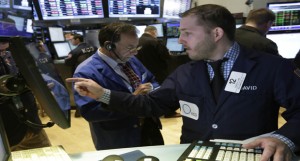
Specialist David Vail, right, works with traders at his post on the floor of the New York Stock Exchange, Wednesday, March 5, 2014. Stocks are little changed in early trading, a day after setting a record high, as traders were unimpressed by a slight increase in hiring at private companies last month. AP PHOTO
NEW YORK—A disappointing production forecast from oil giant ExxonMobil Wednesday pushed the Dow into negative territory on an otherwise flat day for US stocks.
The Dow Jones Industrial Average fell 35.70 (0.22 percent) to 16,360.18.
The broad-based S&P 500 was barely changed, slipping 0.10 of a point (0.01 percent) to 1,873.81. The tech-rich Nasdaq Composite Index added 6.00 (0.14 percent) to 4,357.97.
Dow member Exxon was the biggest loser among the blue chips, sinking 2.8 percent after trimming its oil and gas production forecast as a number of major projects hit snags in the ramp-up phase.
The impact of an exceptionally harsh winter continued to hang over the economy and markets. The Institute for Supply Management’s services PMI fell sharply to its lowest level since February 2010, while the Federal Reserve’s Beige Book said economic activity around the country had eased in January and February, in part due to winter storms. However, the outlook in most areas “remained optimistic,” the report said.
Mace Blicksilver, director at Marblehead Asset Management, said the market is looking ahead to Friday’s monthly jobs report from the Department of Labor, although there is a chance investors would also view a weak report as weather-related.
Banking stocks had a good day, including Bank of America (+3.2 percent), Dow member Goldman Sachs (+1.9 percent) and Citigroup (+1.2 percent).
Dow component General Electric got a lift on reports that chief executive Jeff Immelt bought $3.6 million shares of GE in recent weeks. Shares rose 1.1 percent.
Canadian Solar reported earnings of 39 cents per share, below analyst forecasts of 41 cents. The company’s projection of $415-430 million in sales for the upcoming quarter also fell well below the $513 million expected by the market. Shares dived 10.7 percent.
Acadia Pharmaceuticals lost 5.0 percent, dropping to $28.55 per share, after announcing plans to sell 6.4 million shares for $28.50 per share.
Bond prices were mixed. The yield on the 10-year US Treasury held steady at 2.70 percent, while the 30-year dipped to 3.64 percent from 3.65 percent. Bond prices and yields move inversely.